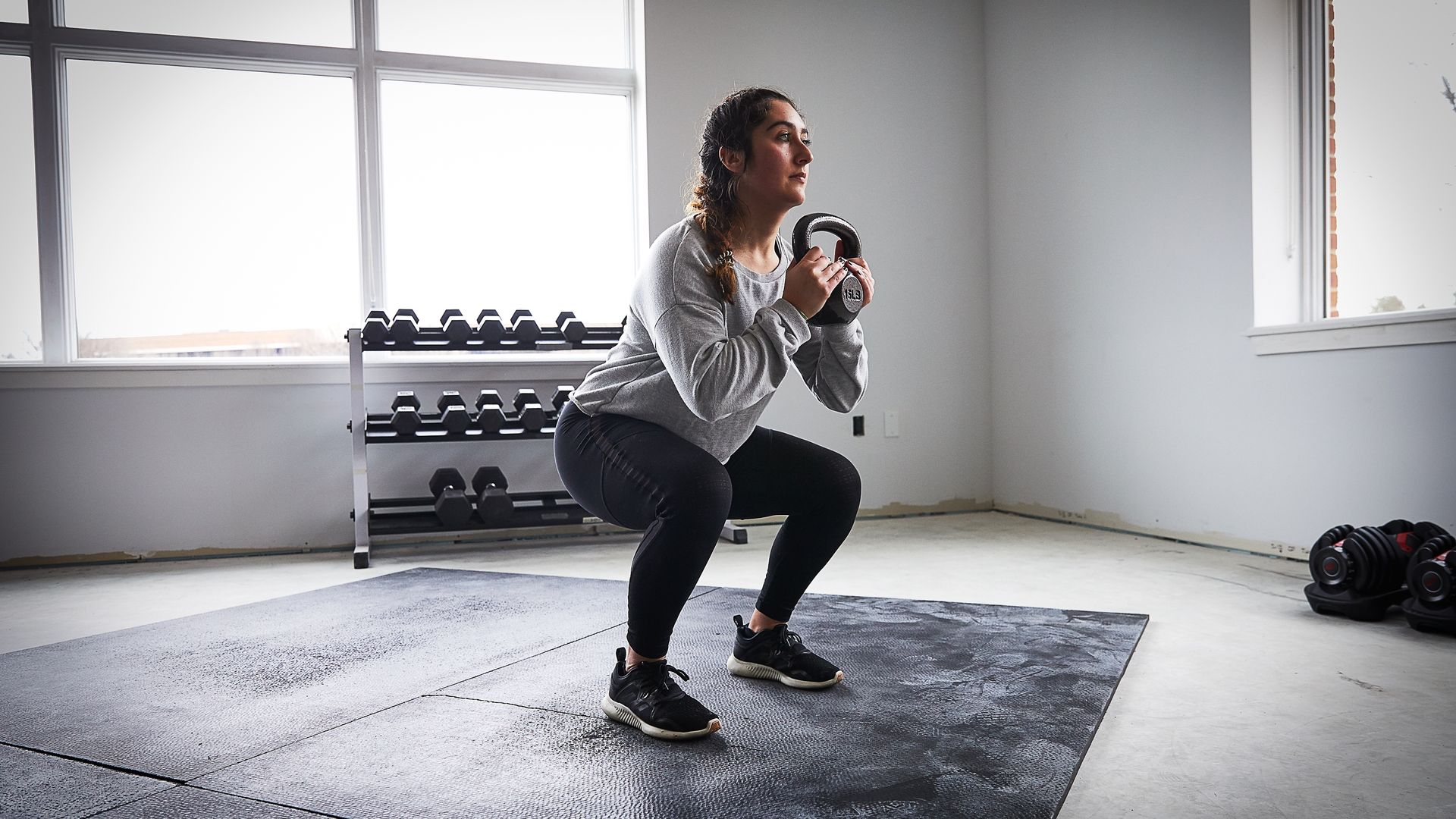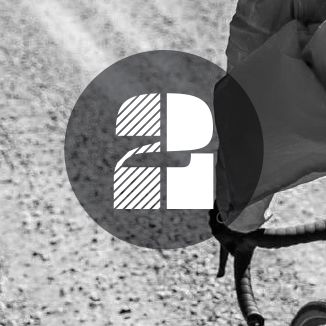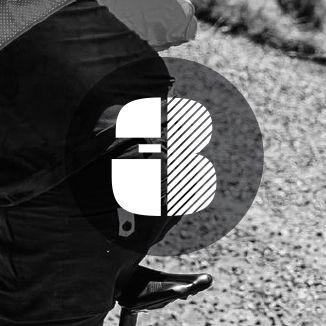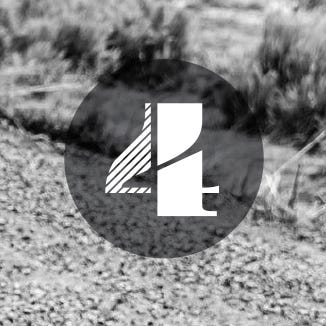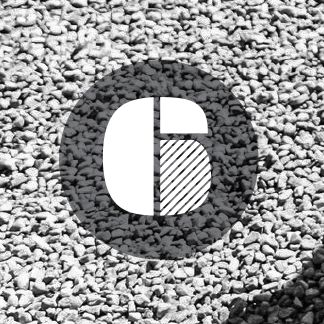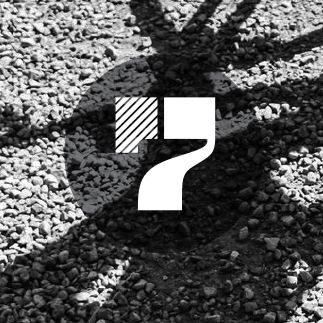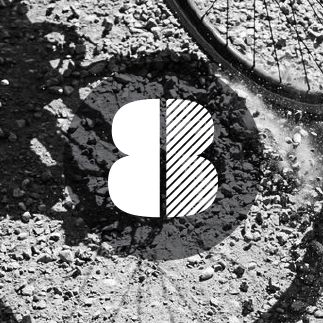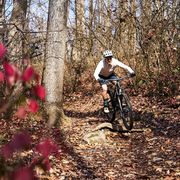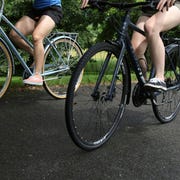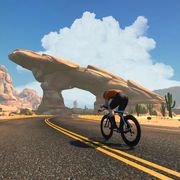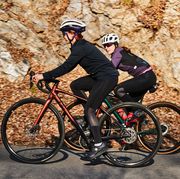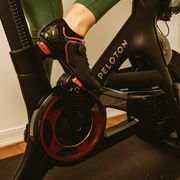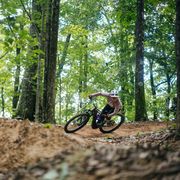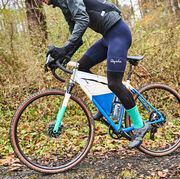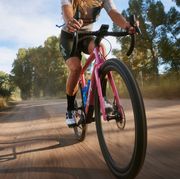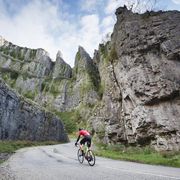Key Points
- Gravel riding requires more full-body strength and stamina than traditional road cycling.
- Lift two or three days a week, favoring moves like the deadlift and squat, especially during off-season to build strength and improve your power.
- Perform a full-body routine at least once a week year-round to maintain strength, especially in your core. Medicine balls are great for this.
- Change things up regularly. Your muscles adapt relatively quickly, so you’ll need to try out new moves, different weights, and/or a change in sets and reps.
What’s missing in many a gravel rookie’s repertoire (as well as some seasoned riders, honestly): gravel-specific fitness. Yep, gravel-specific fitness. Gravel riding (and especially racing) requires a different level of fitness, strength, and stability than the kind you use for pure pavement riding. Don’t believe it? Line up for Mid South 100 in Oklahoma, where you’ll face 107 miles of red, rutted, rural roads that turn to peanut butter when wet and see how that compares with riding your typical century.
Gravel often demands pushing a larger gear at a slightly lower cadence to maintain traction and torque over lumps and bumps. It’s also a total-body workout as you shift your weight, float, hover, and assume all the proper positioning necessary to keep your bike on track and moving forward. That means you need extra leg strength, core stability, and upper-body stamina.
And it’s not just the newfound muscle mass that helps. In fact, the real benefits of strength training are the speed and efficiency you get from making neuromuscular gains in the weight room. When you lift weights, your brain wakes up otherwise inactive muscles, and you forge more neuromuscular connections, so you have more muscle fibers at your disposal. More muscle fibers to work with makes you more efficient on your bike because you have more in reserve to do the work. Full-body strength training also improves your range of motion and makes you more resilient and resistant to fatigue.
That’s why even whippet-thin distance runners are now in the weight room performing traditional power moves such as deadlifts and full squats. Strength training ultimately makes you more efficient, more powerful, faster, and less likely to get hurt.
How and When to Lift
If you’ve never lifted before, it is well worth a bit of time and investment to schedule a few sessions with a certified trainer who can take you through some key moves so you can lift with proper form and confidence.
There is no one routine that is ideal for everyone, though there certainly are key moves that work for most. The most important element to incorporate into any strength training routine is variety. Your muscles adapt relatively quickly, so you need to change things up regularly with new moves, different weights, and/or a change in sets and reps.
To infuse variety into your regular routine, use a training method called daily undulating periodization (DUP for short). DUP training mixes high- and low-intensity exercise as well as volume into the same week, surprising your cycling muscles every workout with different sets, reps, and weights.
To do it, simply incorporate three types of strength workouts: light, medium, and heavy.
- On light-weight days: Perform 2 sets of 10 to 12 repetitions.
- On medium-weight days: Perform 3 sets of 8 to 10 reps.
- On heavy-weight days: Perform 4 sets of 4 to 6 reps.
Rotate through, leaving at least 24 hours between strength training sessions. When you start riding and/or racing more, you can take the heavy-weight days out of rotation and keep it medium or light.
In a study published in the Journal of Strength and Conditioning Research, exercisers who followed this type of undulating plan for 12 weeks increased their lower-body strength in a leg-press test twice as much as exercisers who followed a more traditional strength training plan without weekly variation (56 percent vs. 26 percent), though both groups performed identical training volume over the course of the study.
“By constantly challenging your muscles in different ways, they continue to adapt, so you’re less likely to hit a plateau,” says study author Wayne Phillips, Ph.D. You’re also less likely to get bored.
How often you need to lift depends on your goal. The general gist is this: If you want to gain strength, plan on lifting two or three days a week (more is not always better here; if twice a week fits your schedule, that’s plenty). When it’s time to maintain those gains, once a week is sufficient.
Weight Workouts
You don’t need to spend all day in the weight room to make great gravel-strength gains. Seriously, two or three lifts, such as the ones listed below that hit all the major muscle groups in your upper and lower body will improve your power pretty quickly. Try this strength training trifecta to put more power in your pedals, pronto.
➥ Deadlift
If you do nothing else, I’d recommend the deadlift. It builds strong glutes, which are the lifeblood—and all too often a weak link—of any bike rider. The deadlift also beats the plank when it comes to developing your deep abdominal muscles that give you rock-solid core strength—something every gravel cyclist can use. Do it: Hold two dumbbells or a barbell in front of your thighs, arms extended, palms facing in. Keeping your back flat, hinge at the hips and lower the weight toward the floor; allow your knees to bend slightly. Keep the weights close to your body as you lower them until your upper body is almost parallel to the floor. Contract your glutes and push your hips forward to return to the starting position, and repeat.
➥ Squat
If you want to ride longer and harder, try the squat: the king of cycling moves. One study found that cyclists who added squats to their regular training routine improved their cycling time-to-exhaustion at maximum aerobic power by 17.2 percent after just eight weeks. Do it: Stand with your feet hip- to shoulder-width apart, with your toes slightly turned out. Hold weights at your shoulders or down at your sides. Push your hips back as if you were sitting in a chair and lower down as far as possible while keeping your weight in your heels. Return to the starting position and repeat.
➥ Plank Row
The plank row can be a back and neck saver for endurance cyclists. It develops core strength, upper-back strength, and the stamina needed to support your torso during long days in the saddle. Do it: Start in a high-plank position with your shoulders over wrists, your core, glutes, and legs engaged, and hands holding the handles of two dumbbells so the weights run parallel to your body. Position your feet hip- to shoulder-width apart; the farther apart they are, the easier the move. Keeping your back straight, pull the right dumbbell up to your right side. Return to the starting position and repeat on the other side. Alternate for a full set.
Body-Weight Workouts
For building sheer strength and power, you can’t beat lifting heavy, which for most of us means hitting the gym. If that’s not an option, you can maintain strength and muscular endurance with bodyweight moves. This circuit is also a good workout to do year-round, even during peak riding and racing season.
Perform the exercises below circuit-style, going from one move to the next with minimum rest between moves. Do 10 to 20 reps of each move (depending on your starting strength level). Perform the entire circuit 3 times.
➥ Superman
This move strengthens your glutes, lower back, and erector spinae muscles (the muscles that run along your spine and spend most of their time stretched out and flexed forward when you ride). Do it: Lie facedown on a mat, arms fully extended in front of you, palms down. Squeeze your glutes and simultaneously lift your arms, legs, and chest off the floor. Hold for 2 seconds. Return to the starting position. Repeat. Make it easier: Start by lifting just one arm and leg at a time, alternating sides throughout the set.
➥ Push-Up
This move builds strength in your shoulders, chest, and triceps, which support you on the handlebars. It also improves your core strength and stability—both of which help you punch the pedals. Do it: Start in a high-plank position, your shoulders over wrists, your core, glutes, and legs engaged . Bend your elbows to lower your chest to the floor. Elbows should flare out at a 45-degree angle. Push back up to the starting position, making sure to keep your hips in line with the rest of your body. If you can’t push up without dipping your hips or get your chest to the floor, drop to your knees to do the move. Make it harder: After you perform the push-up, walk your left hand and left foot over to the right so your hands and feet are next to each other. Then walk your right hand and foot back out so you’re in a wide plank position. Perform another push-up and walk your right hand and foot back to the left. Repeat, alternating sides throughout the set.
➥ Shoulder Bridge
This move strengthens your glutes, which are often neglected during rides, and can help keep you stable in the saddle and eliminate back pain. It also strengthens your core and hips. Do it: Lie faceup with your knees bent and feet flat on the floor, hip-width apart. Keeping your thighs parallel to each other, contract your glutes and lift your hips toward the ceiling so your body forms a straight line from shoulders to knees. Rest your arms at your sides, palms down, or intensify the move by clasping your hands beneath your back. Hold for 3 seconds. Return to the starting position. Repeat.
➥ Jump Squat
This move strengthens the prime movers in your pedal stroke, your quads, while also adding some impact to help build bone strength, which cycling alone doesn’t do. Do it: Stand with your feet hip- to shoulder-width apart, toes slightly turned out. Clasp your hands in front of your chest for balance. Push your hips back and bend your knees, dropping into a squat until your butt is below knee level. As you rise back up, explode off the floor and jump. Land softly on the balls of your feet, and immediately lower into another squat. Repeat.
➥ Curtsy Lunge
This move fires up your outer glutes, which are notoriously weak on cyclists. Strong outer glutes can improve your pedaling mechanics and prevent knee pain. Do it: Stand with your feet shoulder-width apart. Clasp your hands in front of your chest. Take a big step diagonally forward with your right foot, crossing your right leg in front of the left. Keeping your back straight, bend your knees and lower your hips toward the floor until your right leg is bent 90 degrees. Return to the starting position. Repeat on the other leg.
Medicine Ball Workouts
Remember, variety is king for gaining and maintaining strength. It also keeps you from getting bored. If you’re someone who is easily bored, try using one of the most versatile pieces of equipment available: a medicine ball.
Medicine balls are particularly great for cyclists because they fire up your central nervous system to keep you sharp, and they’re especially great for developing core strength and stability.
Everyone knows core strength is important for performance. But what you may not realize is that the real power of a strong core is the movement it prevents. Strong abs, obliques, back, and hip muscles specifically prevent unwanted slumping, hunching, and twisting (called “anti-rotation training” in coaching circles), all of which can rob power from your pedal stroke and set you up for aches, pains, and injury.
A strong core also means your body will provide a rock-solid platform for your arms and legs to work against as you pilot your bike over rough terrain. When researchers tested how core stability impacted the pedaling mechanics of 15 competitive cyclists, they found that when the riders’ core muscles fatigued, their pedaling mechanics suffered and their legs began flailing more side to side and less up and down like pistons. That not only wastes watts, but also wreaks havoc on hips, ankles, and knees.
Poor core stability is also a leading cause of back pain on and off the bike. That’s why curls and crunches by themselves are fine for building nice “mirror” muscles, but not much else: They don’t build strength in the muscles that prevent unwanted motion, especially rotation. This is where the awesome medicine ball comes in.
Medicine ball core moves involve twisting, turning, and bending in a wide array of angles, targeting muscles that can be missed during traditional strength training and core work. During the off-season, this routine works well as a third day of strength training or blended into your main routine. During peak riding season, you can use it for your maintenance strength day. Start with a 5- to 10-pound ball and progress as needed to a heavier medicine ball in the 10- to 20-pound range as you become stronger and more comfortable with certain exercises.
➥ Russian Twist
Sit with your knees bent, feet flat on the floor, holding the medicine ball in front of your chest. Lean back at a 45-degree angle to the floor, feet flexed with heels touching the floor. Keeping the ball at your chest, rotate your torso to the right, return to center, then rotate to the left. Return to the starting position. Repeat for 8 to 12 reps per side.
➥ Medicine Ball Crunch
Lie faceup with your knees bent, feet flat on the floor, holding the medicine ball in your arms that are extended above your head. Contract your abs and curl your head and shoulders off the floor, raising the ball overhead and in front of you as you sit up. Reverse the move to return to the starting position. Repeat for 10 to 20 reps.
➥ Triceps Push-Up
Start in a high-plank position with your hands on top of a medicine ball positioned below your chest so your body forms a straight line from your shoulders to your heels. Bend your elbows, keeping your arms tucked close to your sides, and lower your body until your chest nearly touches the ball. Return to the starting position. Repeat for 8 to 12 reps.
➥ Thruster
Stand with your feet hip- to shoulder-width apart and hold a medicine ball close to your chest. Push your hips back and bend your knees and drop into a squat as if you are sitting in a chair until your thighs are parallel to the floor. Stand up, pushing your weight into your heels, and extend your arms to press the medicine ball straight overhead. Return to the starting position. Repeat for 8 to 12 reps.
➥ Wood Chop on One Knee
Kneel on your left knee with your right leg out in front of you, foot flat on the floor, both legs bent 90 degrees. Hold a medicine ball overhead. Swing the ball diagonally across your body to the right, while rotating to the right. Return to the starting position. Repeat for 8 to 12 reps. Switch sides.
➥ Squat Jump
Stand with your feet hip- to shoulder-width apart. Hold a medicine ball in front of your chest. Push your hips back and bend your knees, dropping into a squat, then explosively jump as high as you can. Land softly on the balls of your feet, and immediately lower into another squat. Continue for 45 seconds, then take 15 seconds of rest.
➥ Lunge With Twist
Stand with your feet hip- to shoulder-width apart. Hold a medicine ball in front of you, arms bent about 90 degrees at your sides. Step forward with your left foot and bend both legs 90 degrees into a lunge position. At the same time, rotate your torso to the left, bringing the ball over your knee. Rotate back to center while pushing back to the standing position. Repeat on the other side, alternating for 8 to 12 reps per side.
➥ Single-Leg Deadlift
Stand with your feet close together, holding a medicine ball in front of your chest. Hinge forward from the hips and lift your right leg straight behind you as you lower the ball toward the floor. Contract your left glute and hamstring as you return to the starting position. Repeat for 8 to 12 reps. Switch sides.
➥ Knee Drive
Start with your right leg firmly on the floor, and your left leg placed behind you, with your toes balancing on the floor. Hold the medicine ball out at a diagonal in front of you so your body forms a straight line from the ball to your back leg. Drive your left leg up and bring the medicine ball down to meet it. Continue for 45 seconds, then take 15 seconds of rest.
➥ Single-Leg Hip Bridge
Lie faceup with your arms at your side, knees bent, and feet hip-width apart. Place a medicine ball under one foot and, keeping your thighs aligned, straighten the leg that is not balanced on the ball, so that your toes point up. Squeeze your glutes to lift your hips evenly off the floor, then lower. That’s one rep. Continue for 45 seconds, then take 15 seconds of rest. Repeat on the other side. ❖

